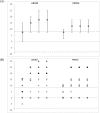THE MUSCLE SHORTENING MANOEUVRE: APPLICABILITY AND PRELIMINARY EVALUATION IN CHILDREN WITH HEMIPLEGIC CEREBRAL PALSY: A RETROSPECTIVE ANALYSIS
- PMID: 34239706
- PMCID: PMC8259804
- DOI: 10.2340/20030711-1000062
THE MUSCLE SHORTENING MANOEUVRE: APPLICABILITY AND PRELIMINARY EVALUATION IN CHILDREN WITH HEMIPLEGIC CEREBRAL PALSY: A RETROSPECTIVE ANALYSIS
Abstract
Introduction: Physiotherapy plays a key role in cerebral palsy rehabilitation, through addressing body function/structure deficits, minimizing activity limitations, and encouraging participation. The muscle shortening manoeuvre is an innovative therapeutic technique, characterized by the ability to induce changes in muscle strength in a short time.
Objective: To describe the applicability and estimate the effect of the muscle shortening manoeuvre applied to improve motor weakness and joint excursion of the ankle in children with hemiplegic cerebral palsy.
Methods: Nine children with hemiplegic cerebral palsy received 3 intervention sessions in one week. Muscle strength, passive and active range of motion were assessed before, during and after the training, and at 1-week follow-up.
Results: The children experienced an immediate increase in muscle strength and joint excursion of the ankle; the improvements were still present at follow-up after 7 days.
Conclusion: The muscle shortening manoeuvre may be an effective intervention to induce an immediate increase in muscle strength and range of motion of the ankle in children affected by hemiplegia due to cerebral palsy, thus promoting better physical functioning.
Keywords: ankle joint; cerebral palsy; continuous passive; motion therapy; muscle strength; physical therapy modalities; recovery of function.
Journal Compilation © 2021 Foundation of Rehabilitation Information.
Conflict of interest statement
The authors have no conflicts of interest to declare.
Figures



Similar articles
-
Does muscle coactivation influence joint excursions during gait in children with and without hemiplegic cerebral palsy? Relationship between muscle coactivation and joint kinematics.Clin Biomech (Bristol). 2015 Dec;30(10):1088-93. doi: 10.1016/j.clinbiomech.2015.09.001. Epub 2015 Sep 8. Clin Biomech (Bristol). 2015. PMID: 26377949
-
Ankle dorsiflexor function after plantar flexor surgery in children with cerebral palsy.J Bone Joint Surg Am. 2011 Dec 7;93(23):e1381-7. doi: 10.2106/JBJS.K.00239. J Bone Joint Surg Am. 2011. PMID: 22159860
-
Functional outcomes following single-event multilevel surgery of the upper extremity for children with hemiplegic cerebral palsy.J Bone Joint Surg Am. 2011 Apr 6;93(7):655-61. doi: 10.2106/JBJS.J.00295. J Bone Joint Surg Am. 2011. PMID: 21471419
-
Asymmetry in sensory-motor function between the lower limbs in children with hemiplegic cerebral palsy: An observational study.Chin J Physiol. 2023 Sep-Oct;66(5):345-350. doi: 10.4103/cjop.CJOP-D-23-00057. Chin J Physiol. 2023. PMID: 37929345
-
Medial gastrocnemius muscle stiffness cannot explain the increased ankle joint range of motion following passive stretching in children with cerebral palsy.Exp Physiol. 2018 Mar 1;103(3):350-357. doi: 10.1113/EP086738. Epub 2018 Jan 31. Exp Physiol. 2018. PMID: 29280208
References
-
- Morgan C, Darrah J, Gordon AM, Harbourne R, Spittle A, Johnson R, et al. . Effectiveness of motor interventions in infants with cerebral palsy: a systematic review. Dev Med Child Neurol 2016; 58: 900–909. - PubMed
-
- Melchiorre D, Maresca M, Bracci R, Ravaschio A, Valiensi B, Casale R, et al. . Muscle shortening manoeuvre reduces pain and functional impairment in shoulder impingement syndrome: clinical and ultrasonographic evidence. Clin Exp Rheumatol 2014; 32: 5–10. - PubMed
-
- Feldman AG, Levin FM. The origin and use of positional frames of reference in motor control. Behav Brain Sci 1995; 18: 723–806.
-
- Blanchette AK, Mullick AA, Moïn-Darbari K, Levin MF. Tonic stretch reflex threshold as a measure of ankle plantar-flexor spasticity after stroke. Phys Ther 2016; 96: 687–695 - PubMed
LinkOut - more resources
Full Text Sources

